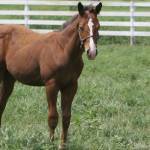Conservative Treatment of Bone Problems in Young Horses

You have a young homebred horse that is growing well and has always been completely sound. You’ve been approached by someone who wants to buy the horse and has asked you to get joint x-rays done. The radiographs have turned up some small lesions characteristic of osteochondritis dissecans (OCD). The prospective buyer said goodbye at this point, and now you’re not sure what to do. Should you ignore the finding, since the horse has never been lame? Or schedule surgery to be sure the lesions won’t get worse? Or try conservative treatment and do a recheck in about six months? Meanwhile, should you rebreed the mare, knowing that she has produced one foal with minor skeletal imperfections?
Checking with your veterinarian is a good first step in deciding how to proceed with this young horse. Treatment usually depends on the size and location of the lesions as well as whether or not the horse is lame. In a lecture delivered at a nutrition conference hosted by Kentucky Equine Research, Dr. Wayne McIlwraith, a veterinarian recognized as an expert in the management and treatment of developmental orthopedic disease, said that surgery is not always necessary for young horses with OCD lesions. Conservative treatment can be appropriate in some instances.
Conservative management may include restricted exercise, periods of stall rest, injections of anti-inflammatory medications either intramuscularly or into the affected joint, and adjustment of the diet to produce a slow, steady plane of growth.
Reporting on a study of horses treated conservatively, McIlwraith said that three crops of foals from the same farm were evaluated radiographically for femoropatellar OCD. In the first foal crop, out of 11 foals confirmed with OCD but not treated surgically, six eventually raced and one became a jumper. Three of the horses were not available for follow-up, and one eventually needed surgery at a later date.
In the next crop, nine foals with clinical and radiographic lesions of OCD were treated conservatively rather than surgically. At the time of follow-up, two of these horses had raced, two were in race training, two were ridden in nonracing disciplines, and three had developed lameness.
Sixteen foals in the third crop were treated conservatively. Of these horses, four were sold as yearlings and were not affected with synovial effusion or lameness. Ten raced or were in race training. One died of unrelated causes and one developed OCD of the metatarsophalangeal joints.
In these horses, there was a trend in these data to indicate that lesser lesions and those without detached cartilage fragments healed with conservative treatment. Surgery is usually a more successful treatment for large lesions and those with obvious fragments in the joint.
As to the question about whether you should rebreed your mare, there is no hard and fast answer to this quandary. Small, self-healing joint lesions are not uncommon in young horses, and many of these disappear in time without causing problems. While genetics may play a role in bone development, a particular mare is quite likely to produce a mixture of trouble-free foals and those with some level of skeletal defects.








